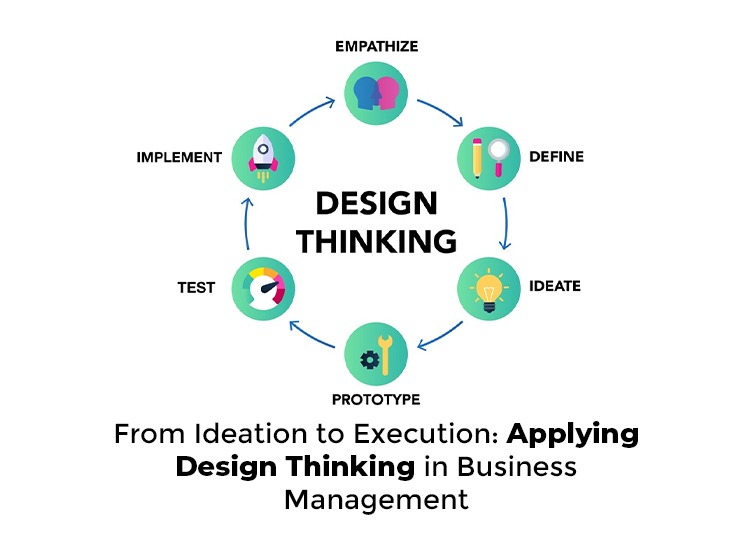
Introduction:
In today’s fast-paced and ever-evolving business world, companies are always on the lookout for ways to innovate and solve complex challenges. One of the most effective methods for achieving this is Design Thinking—a user-centric, creative problem-solving approach that drives both innovation and growth. At MYRA School of Business, Mysore, ranked among the top PGDM Colleges in Bangalore and nearby areas, this methodology is seen as a game changer. Design Thinking empowers businesses to identify pain points, develop solutions, and execute strategies that truly resonate with users’ real needs.
This article explores how Design Thinking can be applied in business management, transforming ideas into practical strategies. It also highlights how leading institutions are incorporating this essential skill into management education to prepare future leaders.
The Essence of Design Thinking in Business Management
Design Thinking is a structured yet creative approach to tackling complex problems. It centres around empathizing with end users, understanding their needs, and using rapid prototyping, testing, and iteration to deliver optimal solutions. In business management, this approach helps organizations rethink processes, innovate, and develop more effective strategies.
By integrating Design Thinking into business management, organizations can:
Foster Innovation: It encourages bold, creative thinking, pushing teams to come up with unconventional ideas.
Enhance Problem-Solving: The iterative process allows managers to explore multiple solutions, refining them to tackle core issues effectively.
Improve User Experience: Focusing on user needs ensures that businesses create products and services that truly connect with their target audience.
The Five Phases of Design Thinking
Design Thinking typically follows five key phases, each essential in turning ideas into reality:
- Empathize: Understanding the end user’s pain points and desires forms the foundation. This could involve gathering feedback from customers or key stakeholders.
- Define: Clearly defining the problem helps pinpoint the core issues that need to be addressed.
- Ideate: In this brainstorming stage, teams generate a wide range of potential solutions, exploring all possibilities without limitations.
- Prototype: Rapid prototyping allows teams to test ideas on a small scale, assessing practicality and effectiveness.
- Test: Testing prototypes provides valuable feedback, helping to refine and improve the final solution before it hits the market.
The Importance of Design Thinking in Business Education
Top business management programs worldwide are increasingly integrating Design Thinking into their curricula. Modern managers face the challenge of balancing technology, customer needs, and business objectives. Design Thinking equips them with critical skills—empathy, creativity, analytical thinking, and problem-solving—that are essential in today’s fast-paced, technology-driven business environment.
Programs that focus on this approach help students develop:
Empathy for Users: A deep understanding of customer needs is crucial for creating impactful solutions.
Creative and Analytical Thinking: Balancing these skills enables managers to devise innovative strategies grounded in real-world practicality.
Problem-Solving Abilities: Design Thinking encourages an iterative approach, essential for adapting to a dynamic business landscape.
From Ideation to Execution: Design Thinking in Action
While Design Thinking starts with empathizing and ideation, executing ideas successfully is where many businesses struggle. Here’s how Design Thinking helps streamline the journey from concept to reality:
- Collaboration Across Departments: Effective execution requires seamless collaboration between departments like marketing, product development, and customer support.
- Embracing Iteration: Businesses must view failure and iteration as part of the process. Each setback offers a learning opportunity to refine solutions.
- Prototyping and Feedback: Rapid prototyping and continuous feedback loops ensure the final product is optimized for both business objectives and user needs.
- Scaling Solutions: After testing and refinement, scaling the solution requires strategic planning and resource allocation.
Real-Life Example: Design Thinking Session with Mr. Rohit Swarup
Recently, the School hosted an insightful Design Thinking session led by Mr. Rohit Swarup, a distinguished expert in the field. In his session, Mr. Swarup highlighted the essential skills future managers need, including technological know-how and psychological insight. His lecture provided valuable perspectives on how innovation and management intersect in today’s complex business environment.
Mr. Swarup’s vast experience includes receiving prestigious awards like the Shiksha Bharti Puraskar and the Indian Leadership Award for Educational Excellence. He has led over 950 seminars worldwide and collaborated with governments in India, China, and Canada to create educational ecosystems focused on technology, management, and design.
As the founder of Xplora Design Skool and Futurz Xplored, Mr. Swarup’s contributions to design thinking and education have reached over 2,000 schools globally. His involvement as a jury member for NID, IIM Ahmedabad, and Gujarat Technological University, along with his mentorship at Niti Aayog’s Atal Innovation Mission, further showcases his impact. His session left students inspired and better equipped to integrate empathy and creative problem-solving into their management practices.
Benefits of Design Thinking for Future Managers:
Design Thinking is not just for designers; it’s a powerful tool for managers who want to foster innovation and lead organizational change. Managers who adopt this methodology can:
Develop User-Centric Solutions: By focusing on users’ needs, managers can create products and services that truly address real-world problems.
Lead Organizational Change: Encouraging creative problem-solving helps build a culture of innovation that drives transformation.
Stay Ahead of Technological Trends: In a world embracing digital transformation, Design Thinking helps managers remain agile and adaptable.
Nurture Continuous Innovation: The process promotes a mindset focused on long-term success and continuous improvement.
Overcoming Challenges in Applying Design Thinking
While Design Thinking has clear benefits, its implementation can come with challenges:
Resistance to Change: Organizations entrenched in traditional processes may resist the disruptive nature of Design Thinking.
Lack of Collaboration: The methodology thrives on interdisciplinary collaboration, and siloed organizations may struggle with this requirement.
Time Constraints: The iterative process can be time-consuming, and balancing short-term results with long-term innovation is essential.
The Future of Design Thinking in Business Management
As businesses evolve, so will the role of Design Thinking. In an increasingly digital and interconnected world, the ability to think creatively and empathically is more valuable than ever. Companies that embrace Design Thinking will be better positioned to innovate, grow, and adapt to market changes.
By integrating this approach into business management education, institutions like MYRA School of Business are ensuring that future leaders are equipped to navigate an ever-changing environment. Design Thinking fosters an agile mindset, preparing managers to address the complex challenges of tomorrow.
Conclusion
At MYRA School of Business, Mysore, which stands among the Best PGDM College in Bangalore and nearby areas, Design Thinking is more than just a methodology—it’s a mindset that transforms how business leaders approach innovation, problem-solving, and execution. From ideation to implementation, Design Thinking fosters creativity, empathy, and collaboration, all of which are critical to success in the modern business landscape. By equipping future managers with these skills, business management programs ensure their graduates are ready to lead with innovation, adaptability, and purpose in an ever-evolving world.


